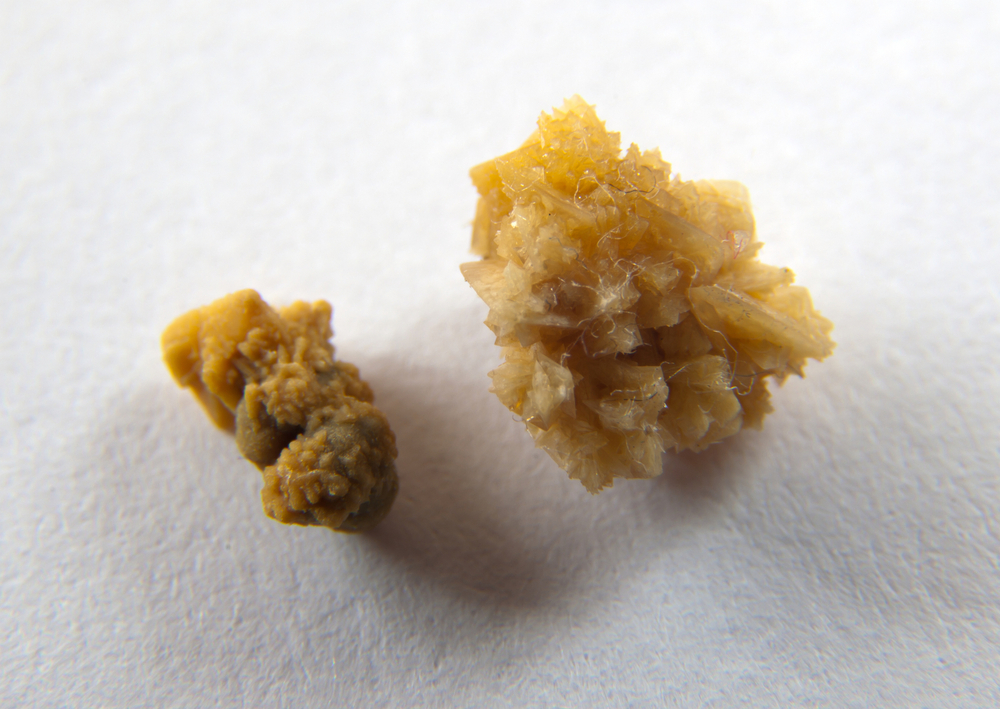Your dog's diet is a powerful tool to effectively manage various medical conditions
Diet for Calcium Oxalate Stones in Dogs
If you have a dog with calcium oxalate stones and would like to feed a homemade diet, please email me. I’ll be happy to help.
Updated January 2026 by Kristina Johansen
What can I feed my dog with calcium oxalate stones?
Nutrition plays a crucial role in managing and preventing calcium oxalate stones in dogs. In this guide, our focus will be on dietary management (protein, oxalate, calcium, and more); however, we’ll also cover:
- Signs & symptoms
- Treatment options
- The importance of Urinary pH and urine specific gravity (USG)
- Why hydration matters
- FAQs on calcium oxalate stones in dogs
Let’s dive in!
Why did my dog form calcium oxalate stones, and what are they?
Calcium oxalate stones form when calcium and oxalic acid bind together in urine. Normally, these two chemicals can coexist without causing problems, but if the urine is too acidic—or if their levels are unusually high—they can combine to form calcium oxalate crystals. The bladder cannot dissolve or easily excrete these crystals, so they can lodge and grow into stones.
Dogs (and people) usually produce a protective protein called nephrocalcin in the kidneys, which is released into the urine and helps stop calcium and oxalate from binding. In some dogs, nephrocalcin doesn’t work properly (usually due to genetics), making stones more likely.
Scientists don’t yet fully understand all the interactions between this protein and minerals, but we do know that certain breeds, such as Bichon Frises, Miniature Schnauzers, Yorkshire Terriers, and Shih Tzus, are more prone to calcium oxalate stones, and that bladder stones are more common in male dogs.
The signs and symptoms of calcium oxalate stones (CaOx)
The most common signs of stones in your dog’s bladder are difficulty urinating (dysuria) and blood in the urine (haematuria).
Urinating becomes difficult because the presence of stones in the bladder causes it to swell and become inflamed. Or, the stones physically obstruct the bladder – both of which mean urine isn’t able to pass through to the urethra (the tube that carries urine from the bladder and outside the body)
Blood in the urine (haematuria) happens because the stones rub against the bladder wall, causing damage, irritation and bleeding.
In case you’re curious, this is what a calcium oxalate stone would look like when removed. Imagine what this would feel like in your bladder.
How will my vet treat CaOx stones?
For most dogs, calcium oxalate stones are removed via surgery, which is the simplest, most direct way to remove them.
While there can be other options to remove stones (see below), surgery tends to be the only option when stones are bigger and when there are a lot of them. It’s also the recommended method of removal for male dogs because there’s a higher risk that the stones will cause obstruction and damage to the bladder.
Surgery doesn’t always remove every trace of the stones, which is why, following surgery, vets tend to ‘flush’ the bladder to remove any lingering traces of them. Unfortunately, even with flushing, removing everything can be impossible, meaning some trace of the stones remains. This is why it’s common for calcium oxalate stones to form repeatedly. However, as we’ll discuss later, diet plays a vital role in reducing the likelihood of this happening.
If the calcium oxalate stones are small enough (and there aren’t many), flushing the bladder can remove them. This procedure is usually done when your dog is heavily sedated or under anaesthesia.
Stones can also be removed via a cystoscopy, a cystoscope passed up through the urethra and into the bladder to break down the stones. This produces stone fragments that are small enough to be expelled naturally through the urine. Again, this procedure will only work if the stones are small and there aren’t many of them.
This is not an exhaustive list of how calcium oxalate stones can be removed. Your veterinarian will discuss the options with you to find the one most suitable for your dog.
Diet for calcium oxalate stones in dogs
To decrease the likelihood of your dog forming calcium oxalate stones, there are several key dietary modifications you should be making.
Water
Keep your dog well hydrated. Increased water consumption makes urine more dilute, which in turn dilutes the levels of chemicals that promote stone formation. You can help your dog drink more water by placing several bowls of fresh water in different locations around the house. Ideally, we are aiming for a urine specific gravity (USG) below 1.020 (for reference, water is 1.000).
Oxalate
Avoid foods with high levels of oxalate, such as spinach, sweet potatoes, organ meat and brown rice. Instead, include foods low in oxalate, such as peeled apples, white rice, meats, and fish (except sardines) in your dog’s diet. It’s also a good idea to boil vegetables and drain the water before giving them to your dog – this helps reduce their oxalate levels.
It’s worth noting that not all oxalate comes from the diet. Some is naturally produced in the dog’s body, mainly by the liver. Even so, limiting high-oxalate foods in your dog’s diet is an important step in preventing calcium oxalate stones.
Protein
In people, eating a lot of animal protein is linked with a higher risk of calcium oxalate stones. In dogs, however, the picture looks different. Studies suggest that dogs fed foods with moderate to higher protein levels actually had fewer calcium oxalate stones, especially when the protein comes from good-quality sources. The takeaway is that both too little and too much protein may cause problems. For homemade diets, the goal is to provide the right amount of high-quality protein for your dog’s needs.
Calcium
Many dog owners worry about adding calcium to their dog’s homemade diet because of the name “calcium oxalate stones.” But research shows that avoiding it can actually make things worse. Calcium binds to oxalate in the digestive tract, helping to limit how much is absorbed and passed into the urine. Without enough calcium, more oxalate enters the urine and increases stone risk. Calcium is also an essential mineral for overall health, and a deficiency can lead to serious problems such as osteoporosis.
The key is balance: provide enough calcium to meet your dog’s needs and reduce oxalate absorption, but not so much that it drives excess calcium into the urine. Because the amount must be very carefully controlled, calcium should only be added under the guidance of a qualified professional.
Sodium
Although research in dogs has shown that increasing sodium in prescription diets can sometimes help by encouraging more drinking and diluting urine, this approach isn’t suitable for homemade diets. Adding extra salt can increase calcium loss in urine and raise the risk of stones. A safer strategy is to focus on boosting water intake by adding moisture to meals.
Vitamin D
Vitamin D helps dogs absorb calcium, but too much can lead to greater calcium absorption from food and more calcium being passed into the urine. For that reason, homemade diets should meet, but not exceed, a dog’s vitamin D requirements.
Vitamin C
When vitamin C is broken down in the body, it produces oxalate. Supplementing with vitamin C can therefore raise oxalate levels, so it’s best avoided in dogs prone to calcium oxalate stones. Additionally, dogs produce their own vitamin C, so there’s no need or benefit to adding extra in a homemade diet.
Vitamin B Compound
Vitamin B6 helps prevent excess oxalate from being produced in the body. Since B vitamins are water-soluble and easily lost in urine — and dogs with calcium oxalate stones are encouraged to drink more to keep their urine dilute — ensuring enough vitamin B in your dog’s diet is essential.
Fish oil
Calcium oxalate stones can irritate the bladder wall and cause inflammation. To help reduce this inflammation, you can give your dog a fish body oil supplement. However, avoid cod liver oil, as it contains vitamin D (see above).
Urine pH
Calcium oxalate stones form in urine that is too acidic (less than 6.5). So another way calcium oxalate stones can be prevented is by maintaining a more basic urine pH – ideally between 6.5 and 8.0. For reference, healthy dogs usually have a urine pH between 6.0 and 7.5.
Diet can influence pH. Generally, high-protein foods tend to make urine more acidic, while carbohydrate-rich foods can make it more alkaline. Other factors, such as overall diet balance and health conditions, also play a role.
If you want to monitor your dog’s urine pH at home, you can test it using a pH strip. Catch some of the first urine of the day midstream, preferably before a meal. If the urine is too acidic, pH can be raised with a potassium citrate supplement — but this should only be done under professional guidance.
Just keep in mind that urine pH naturally varies. The key is to monitor the pH and know where you are, but not to panic if the urine remains more acidic than you would like. And remember, it is more important to keep your dog’s urine dilute (<1.020), rather than chasing a “perfect” pH.
Key takeaways
Bladder stones aren’t a pleasant thing for a dog to develop. They can be extremely painful and even potentially fatal. The good news is that by following dietary recommendations and monitoring urine, you can significantly reduce the chances of stones returning in dogs that have had them before.
Key nutritional goals include:
- Encourage increased water consumption to keep urine dilute
- Choose a high-moisture diet
- Avoid high-oxalate foods and Vitamin C supplements
- Provide balanced calcium intake and avoid excess vitamin D
- Consider a fish body oil supplement
FAQs on calcium oxalate in dogs
We have reached the end of the blog. I hope the information has helped you better understand the necessary changes to manage your dog’s calcium oxalate stones effectively. If you’d like quick answers to the most common questions about calcium oxalate stones in dogs, please visit my FAQ page: FAQs on Calcium Oxalate Stones in Dogs. It’s a helpful companion to this article and covers many of the everyday questions owners have.
If you have any further questions or need help, don’t hesitate to contact me. Your feedback and suggestions are always welcome. To learn more about my approach and credentials, please visit my ‘About Page‘.
Meet Bobby
Before you go, I would like to introduce you to Bobby and share this lovely message I received from his owner.
“Thank you Kristina. 18 months on your diet for our calcium oxalate stone forming dog and we have no further stones and bladder is in good health. Prior to your diet his stones returned 9 months after surgery. Massive thank you for all your help and advice“

About the author:
Kristina Johansen, MSc cand. (Animal Nutrition), Cert ACN, is a dog nutritionist with over 15 years' of experience. She's a member of the American Academy of Veterinary Nutrition (AAVN) and the European Society of Veterinary & Comparative Nutrition (ESVCN). She specialises in home-prepared dog diets that meet NRC guidelines. Learn more →Disclaimer: The information provided in this blog is meant for informational and educational purposes only. Please don’t try to create or modify your dog’s diet based on the information provided. Diet formulation for dogs with health concerns is complex. If you’re considering a homemade diet for your dog, please ensure it is formulated by a qualified dog nutritionist.
Diet & Health Advice
If you have a dog with calcium oxalate stones and would like to feed a homemade diet, please email me. I’ll be happy to help.
Book a Consultation
